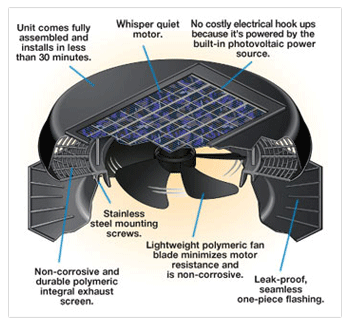Suppose you own a business and you have a choice between two employees: One who shows up for work on a regular basis and provides consistent, reliable results, and one who shows up now and then and works only occasionally, with highly variable results. Of course, you’d pick the first employee who offers the most benefits for your business – and the least amount of frustration and disappointment.
Solar Star vs. Standard Wind Vents
Believe it or not, choosing between a solar-powered roof ventilation system and a wind-powered vent is somewhat similar: Wind vents are only effective when the wind is moving; occasional gentle breezes, as enjoyable as they may be while you’re spending time outside, aren’t going to do much for moving the hot air and humidity out of your home.
On the other hand, Solatube’s Solar Star roof ventilation system uses a solar-powered fan that’s designed to move large amounts of air any time the sun is shining – even on partly cloudy days and days when there’s no wind at all. In fact, in the heat of midday when barely a breath of air is moving, your solar-powered fan will be hard at work, cranking out the heat and humidity from your home to help make every floor of your home more comfortable. It will also ease the burden of your air conditioning system, so it doesn’t have to work as hard or use as much electricity.

Why is consistent air movement important?
In the hottest months of the year, your attic space can reach temperatures of as high as 60 degrees Celsius, and although hot air wants to rise, when it’s trapped by your roof, it winds up heating the air on the lower floors instead. All that trapped heat can create significant problems with your roof, causing extreme heat damage to shingles and underlay. Plus, if the weather turns humid, the air inside your attic can become damp, providing an ideal place for mould and mildew growth.
Keeping the air in your attic moving and giving it some place to escape is critical to helping maintain the integrity of your roof, as well as maintaining comfort in your home. In addition, by removing damp, humid air and encouraging air movement, a Solar Star ventilation system can be a powerful ally in preventing damaging and unhealthy mould growth.
Just how good is a Solar Star ventilation system?
Very good.
Wind vents will typically move 85-100m³ of air per hour (air extraction typical of a 250mm diameter product), they are quite inefficient. This level of air extraction is similar to taking a tile off your roof and covering it with a static cap. Yes, 1-4 wind vents will still impact your home, but to achieve good results you should look at 3 air changes per hour (5 is even better). Based on that calculation, most homes should have 6-8 wind vents, while a single Solar Star will exceed that level of ventilation even on a cloudy day. The cost of installing 3 quality wind vents equates to one Solar Star.
If you’re considering an economical way to keep your home cooler, drier and healthier, ditch the wind vents; the Solatube Solar Star roof ventilation should be at the top of your list. To learn more about the Solar Star and how it can help you keep your home cooler and drier, contact Solatube to find a dealer near you.


I would like to ventilate a composting toilet at our hobby farm without having to have a 240v connection driving the fan.
Can your unit attach to a breather pipe and how much does it cost?
Could you please give me the dimensions too.
Hi K J,
Our solar powered vents are generally designed as residential roof ventilators that do not have any ducts attached and air allowed to flow freely, typically exchanging the air in the roof five times per hour. So the main consideration would be how much additional pressure you’ll get with the pipe (length and diameter), and how quickly you’ll be removing air from the composter with a mechanical fan (volume, fan’s airflow and any air intakes). Excessive pressure will reduce airflow, and may stress the motor beyond design intent. Although we do not test our fans under these conditions, if you were to attach these to a pipe, we’d suggest that the pipe is no smaller than the fan throat diameter (either 250mm or 350mm depending on model). For pricing on the 250mm V-Aero or the 350mm RM-1600, contact your local Solatube dealership.
what is the flow rate on the mecahnical fan used insidea solatube skylight?
Hi Anne,
The only ventilation system for Solatube Skylights is a Ventilation Add on Kit, the article you refer too is for Roof Ventilation which is the V-Aero 250 and RM 1600. If you can advise which product you are looking for flow rate data on, then we can assist further.